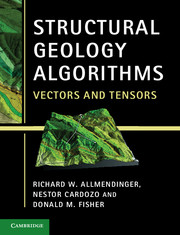Book contents
- Frontmatter
- Contents
- Preface
- Chapter One Problem solving in structural geology
- Chapter Two Coordinate systems, scalars, and vectors
- Chapter Three Transformations of coordinate axes and vectors
- Chapter Four Matrix operations and indicial notation
- Chapter Five Tensors
- Chapter Six Stress
- Chapter Seven Introduction to deformation
- Chapter Eight Infinitesimal strain
- Chapter Nine Finite strain
- Chapter Ten Progressive strain histories and kinematics
- Chapter Eleven Velocity description of deformation
- Chapter Twelve Error analysis
- References
- Index
Chapter One - Problem solving in structural geology
Published online by Cambridge University Press: 05 June 2012
- Frontmatter
- Contents
- Preface
- Chapter One Problem solving in structural geology
- Chapter Two Coordinate systems, scalars, and vectors
- Chapter Three Transformations of coordinate axes and vectors
- Chapter Four Matrix operations and indicial notation
- Chapter Five Tensors
- Chapter Six Stress
- Chapter Seven Introduction to deformation
- Chapter Eight Infinitesimal strain
- Chapter Nine Finite strain
- Chapter Ten Progressive strain histories and kinematics
- Chapter Eleven Velocity description of deformation
- Chapter Twelve Error analysis
- References
- Index
Summary
Objectives of structural analysis
In structural analysis, a fundamental objective is to describe as accurately as possible the geological structures in which we are interested. Commonly, we want to quantify three types of observations.
Orientations are the angles that describe how a line or plane is positioned in space. We commonly use either strike and true dip or true dip and dip direction to define planes, and trend and plunge for the orientations of lines (Fig. 1.1). The trend of the true dip is always at 90° to the strike, but the true dip is not the only angle that we can measure between the plane and the horizontal. An apparent dip is any angle between the plane and the horizontal that is not measured perpendicular to strike. For example, the angle labeled “plunge” in Figure 1.1 is also an apparent dip because line A lies in the gray plane. Strike, dip direction, and trend are all horizontal azimuths, usually measured with respect to the geographic north pole of the Earth. Dip and plunge are vertical angles measured downwards from the horizontal. Where a line lies in an inclined plane, we also use a measure known as the rake or the pitch, which is the angle between the strike direction and the line. There are few things more fundamental to structural geology than the accurate description of these quantities.
- Type
- Chapter
- Information
- Structural Geology AlgorithmsVectors and Tensors, pp. 1 - 22Publisher: Cambridge University PressPrint publication year: 2011



